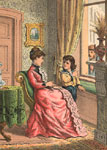Gypsy Life
In Dutch childrens' books 1825-1990
 Gypsy life is highly imaginative. Gypsies are generally portrayed as lazy and unreliable: they live by begging and poaching, stealing chickens and robbing children. But the stereotype of the gypsy is also free and unconstrained, passionate and fond of music. We can reconstruct the imagery of gypsy life from a wide range of Dutch childrens' books collected by the anthropologist dr Jean Kommers from Nijmegen University. This collection, now at the IISH, covers the period from 1825-1990 and holds more than three hundred book titles.
Gypsy life is highly imaginative. Gypsies are generally portrayed as lazy and unreliable: they live by begging and poaching, stealing chickens and robbing children. But the stereotype of the gypsy is also free and unconstrained, passionate and fond of music. We can reconstruct the imagery of gypsy life from a wide range of Dutch childrens' books collected by the anthropologist dr Jean Kommers from Nijmegen University. This collection, now at the IISH, covers the period from 1825-1990 and holds more than three hundred book titles.
In this juvenile literature about gypsies, the contrast between dark and light, filthy and clean, ugly and beautiful, black and blonde is emphasized. But evil is not always found on the dark side. Around 1930 the thief in a story would  undoubtedly be a gypsy, but around 1970 the gypsy only appears to be the thief: some malevolent person has left gold in the gypsy's caravan to make him a suspect. Only in the last part of the twentieth century has the male gypsy been seen as a handsome, warmblooded, decent person, whereas his young female counterpart has always been breathtakingly beautiful.
undoubtedly be a gypsy, but around 1970 the gypsy only appears to be the thief: some malevolent person has left gold in the gypsy's caravan to make him a suspect. Only in the last part of the twentieth century has the male gypsy been seen as a handsome, warmblooded, decent person, whereas his young female counterpart has always been breathtakingly beautiful.
A great many children's books date from the thirties and fifites. Gypsy culture was sharply contrasted against the well-behaved ways of life of the Dutch. A terrible fate befell a child kidnapped and raised by gypsies. On the other hand, gypsy children who had been sold or left by their parents to be raised in 'civil society', were never completely at home there. The politically correct books from the seventies and eighties emphasize the otherness of gypsies just as well. They show compassion with the gypsy's fate during World War II and picture the gypsy as a victim of repression. A frequent theme in these books is kidnapping, which was a pedagogical device to frighten children and enforce obedience. Although there are many images of kidnapping over the years,  the perspective changes drastically. Thus, in a book from 1987, a gypsy boy would tell three Dutch boys on biking tour: 'Have you ever heard of gypsies kidnapping children? Sheer nonsense of course, gypsies are fond of their sons and daughthers!' The number of gypsies in Dutch society never exceded a few hundred, which is probably less than the amount of books about them.
the perspective changes drastically. Thus, in a book from 1987, a gypsy boy would tell three Dutch boys on biking tour: 'Have you ever heard of gypsies kidnapping children? Sheer nonsense of course, gypsies are fond of their sons and daughthers!' The number of gypsies in Dutch society never exceded a few hundred, which is probably less than the amount of books about them.
A selection from the Kommers-collection shows different styles and pictures of gypsy life. The IISH acquired this collection in 1999 together with the archive of the Lau Mazirelstichting.
Further reading:
Jean Kommers, Kinderroof of zigeunerroof. Zigeuners in kinderboeken. Utrecht, 1993
